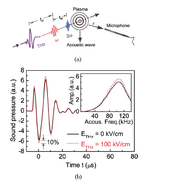Highlight
"Hearing" terahertz electromagnetic radiation
Achievement/Results
The NSF sponsored IGERT trainee Ben Clough and his collaborators at the Center for Terahertz Research, Rensselaer Polytechnic Institute, Troy, NY have demonstrated THz-enhanced acoustics (TEA), a useful method for THz wave detection. The enhancement of acoustic waves, from audible into the ultrasonic range, is a linear function of the THz intensity incident on a laser-induced plasma, making THz-enhanced acoustics (TEA). See Figure 1(a). During a single-cycle THz pulse with its peak field of 100 kV/cm, a pressure enhancement of 10% is observed throughout the acoustic spectrum up to 140 kHz, and the TEA signal is found to increase linearly with THz wave intensity. See Figure 1(b). Using a dual-color laser field to control electron trajectory inside the plasma, THz spectroscopic information can be encoded into the acoustic emission, making it possible to obtain the electric field profile of a THz pulse by simply “listening” to the plasma. A nearly instantaneous heating of a gas emits a shock wave through photoacoustics that quickly relaxes into an acoustic wave. The acoustic pulse contains a broad spectrum of frequencies that extend well beyond the range of human hearing into the ultrasonic range. When a broadband THz pulse is focused collinearly and simultaneously onto the plasma region, the THz field serves to accelerate freed electrons, giving them additional kinetic energy. Subsequent electron acceleration and collision between neighboring air molecules results in a THz field-induced energy transfer which gives rise to terahertz-enhanced acoustics (TEA). Potential applications of these experimental findings include a promising method for coherent THz wave detection at remote distances, and as a diagnostic tool for dynamic plasma interactions with electromagnetic radiation.
For further details see published paper
“Laser-induced photo acoustics influenced by single-cycle terahertz radiation” by Ben Clough et al., Optics Letters, v 35, n 21, p 3544-6, 1 Nov. 2010.
Address Goals
The discovery of TEA (terahertz-enhanced acoustics) advances the frontiers of terahertz science knowledge. It also has potential applications in remote sensing. It keeps the US in a leading position of terahertz science and engineering.
In the process of TEA discovery the IGERT trainee and collaborators learned to work together and developed science and engineering skills as well as disseminated findings to society through outreach activities and professional conferences.






